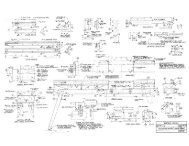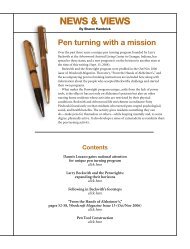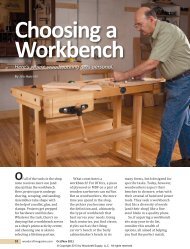42-Table Saw Safety3.indd - Woodcraft Magazine
42-Table Saw Safety3.indd - Woodcraft Magazine
42-Table Saw Safety3.indd - Woodcraft Magazine
You also want an ePaper? Increase the reach of your titles
YUMPU automatically turns print PDFs into web optimized ePapers that Google loves.
and accuracy. (Looking for<br />
a sled plan? Refer to Issue<br />
#34 [April/May 2010], or<br />
go to woodcraftmagazine.<br />
com/onlineextras.)<br />
Crosscutting Multiples<br />
Avoiding<br />
crosscut kickback<br />
The two most common<br />
causes of crosscut kickback<br />
are crosscutting panels<br />
using the rip fence, and<br />
pinching the offcut between<br />
the blade and a stop when<br />
cutting multiples to length.<br />
To be honest, the first<br />
is a procedure commonly<br />
performed by professionals<br />
because of its efficiency. It’s<br />
effective, as long as the fencebearing<br />
edge is long enough to<br />
provide stability, but it must be<br />
done with care, as explained in<br />
the sidebar (page <strong>42</strong>). Better<br />
yet, use a crosscut sled.<br />
Cutting multiples to length<br />
using the rip fence as a stop<br />
pinches the offcut between the<br />
blade and rip fence, resulting in<br />
kickback almost every time. To<br />
prevent this, use a “standoff”<br />
stopblock clamped to the fence,<br />
as shown in Photos L and M.<br />
L<br />
Register the end of a workpiece<br />
against a standoff block clamped to<br />
the rip fence forward of the blade.<br />
Clamp the standoff block to the<br />
fence far enough in front of the<br />
blade to allow the workpiece<br />
to clear it before it contacts the<br />
blade. With the work pressed<br />
against the block, position<br />
the fence to align the cut with<br />
the blade. You can then safely<br />
saw without kickback.<br />
Crosscutting small pieces<br />
Most of us have small pieces<br />
of precious wood that we<br />
sometimes need to cut to make<br />
pulls and accents. To keep your<br />
M<br />
Holding the work firmly, make<br />
the cut. The untrapped offcut<br />
can now fall away safely.<br />
fingers out of harm’s way, you<br />
can create a hold-down by<br />
“bridging over” from a piece of<br />
scrap of similar thickness, as<br />
shown in Photos N and O. n<br />
About Our Author<br />
Paul Anthony, <strong>Woodcraft</strong><br />
<strong>Magazine</strong> senior editor<br />
and author of Taunton’s<br />
Complete Illustrated Guide<br />
to <strong>Table</strong>saws, can still count<br />
to ten using his fingers.<br />
Crosscutting Small Workpieces<br />
N<br />
Small pieces can be held safely against a miter<br />
gauge (above) or a crosscut sled (right) by “bridging<br />
over” from a piece of scrap of the same thickness.<br />
O<br />
Glue fine sandpaper<br />
to bridge for<br />
best control.<br />
Aug/Sept 2011 woodcraftmagazine.com 43










